Editor’s Note: This is the final installment of Thad Komorowski’s posts reprinting rare promotional print cartoons that originally appeared weekly (sometimes intermittently) from 1934 through 1945 in the in-house trade publication “Paramount Sales News”. For a Fleischer/Famous fan such as I these posts are invaluable. Compiling these took extraordinary effort and I cannot thank Thad enough.
And though these print pieces end here – it isn’t the end of Famous Studios here on Cartoon Research. Especially now, when it begins to get interesting with the addition of Casper on screen and Bill Tytla behind the scenes. Starting on June 8th, I’m going to attempt to continue to talk Famous with new posts about the studio each week – in chronologic order, beginning with the 1945-46 season – right here every Monday.
Next week, June 1st, in this spot will be a guest post by none-other than Gene Deitch with an exclusive story – just for our readers – about his dealings with MGM, tied to the release of Warner’s new DVD box set “Tom & Jerry: The Gene Deitch Collection”. Don’t miss this! – Jerry Beck
1945
The end of the line! I’ve got to say it’s been a pleasure doing these posts. I’m writing this at the Cinevent convention in Columbus, Ohio, and I’m rather stunned by the compliments and handshakes I’ve gotten, for these posts and my animation history work in general. Kind words from complete strangers, and even people you’ve long admired, like John McElwee of the amazing Greenbriar Picture Shows. Internet comments are always nice but there’s nothing like being told face-to-face that what you do means something. (Even if in the grand scheme of things it’s pretty pointless.)
Paramount Sales News abruptly dropped the panels in 1945, which spoke volumes of what was going on with Famous Studios at the time, and Paramount’s attitude towards the place.
Several key animators and writers left, the Technicolor backlog became a major hassle (for all the studios), and the cartoons themselves were fast hitting a creative standstill. Word even leaked to the press that the home of Popeye and Little Lulu was shutting down for good (even though it wasn’t).
It’s safe to say that by 1945, Paramount officially didn’t care about Famous Studios. As far as the brass was concerned, Famous simply made Popeye and kept them in the running of shorts distribution. I almost missed the September 6th panel advertising Casper’s debut (drawn better here than in the actual film) because it was buried under a sea of text, as opposed to the prominence the panels usually got.
I’m being intentionally vague about what went on at Paramount in this post, because the full story of what happened at Famous Studios, and in the New York animation industry, will be told soon. Charlie Judkins (whose early NY animator profiles you’ve all enjoyed) and I are collaborating on something that’s been sorely needed for several decades. That’s all I’m saying for right now. More very soon..


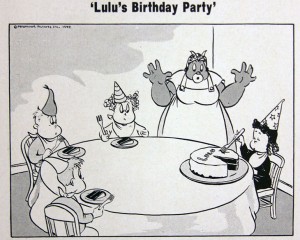


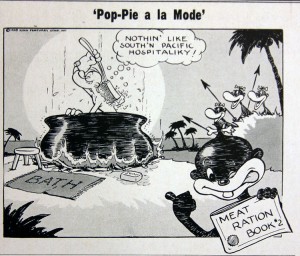



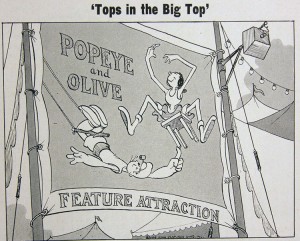

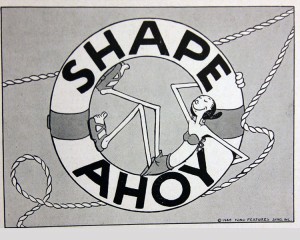


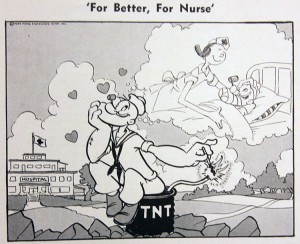


 THAD KOMOROWSKI is a writer, journalist, film restorationist and author of the acclaimed (and recently revised) Sick Little Monkeys: The Unauthorized Ren & Stimpy Story. He blogs at
THAD KOMOROWSKI is a writer, journalist, film restorationist and author of the acclaimed (and recently revised) Sick Little Monkeys: The Unauthorized Ren & Stimpy Story. He blogs at 
























































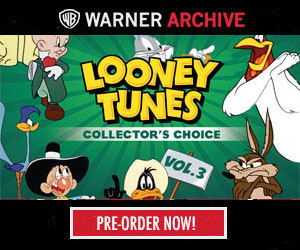
Did they ever mention Famous Studios or any of their characters after they dropped the regular panels?
Heh, sorta gives the impression that Casper killed off any future Paramount Sales News features for Famous, though it’s obvious that Paramount simply stopped caring enough to advertise its cartoon division.
Thad, I would also like to thank you for all the work done on this long ongoing project. Look forward to your next article.
Regarding “When GI Johnny Comes Marching Home”, I believe this is the first Screen Song they advertised since its revival.
Thad-
‘Tis a cryin’ shame that you “sick little monkey” (a reference to your book) is finishing up your INCREDIBLE series of rare adverts from Fleischer/Famous- me poisonal fave you’ve posted here was probably the “connect-the-dots” one with Popeye holding a pig. Excited fro Mr. Deitch’s post, tho’.
Thank you for these posts; they’ve been a real treat!
I’ve really enjoyed these Paramount cartoon ads. Thanks for posting them!
I see that they did a second ad for “She-Sick Sailors” that depicted the Superman connection.
I’m also looking forward to Gene Deitch’s story of the Tom & Jerrys he made.
“Pointless” my eye! This has been a fascinating glimpse into the history of Paramount’s involvement with animation, as you can see the rise and fall of both Fleischer and Famous over the course of a decade, and what Paramount felt was the best to ballyhoo about them. For example, unless there’s text we aren’t seeing, they go from plugging the shorts as almost guaranteed box office moneymakers to just funny cartoon panels to break up what must have been walls of text and charts.
I thank you now for undertaking this project Thad, and if your next project is what I think it is I’ll owe you an even bigger thank you soon, and perhaps some money as well!
Popeye Ala Mode was one of my favorite Famous Studio cartoons from the “early years” (1945) along with “Her Honor the Mare ” (a play on the word Mayor) and Were on Our Way to Rio (A spoof on the Bing Crosby-Bob Hope Road To movies) with Olive Oyl singing in Brazilian Portuguese (And I’m still wonder who did Olive’s singing voice for that cartoon? Surprisingly I saw Popeye Ala Mode on a Mexican tv station (XHGC TV 5) back in the 1990’s when it was banned from the US by the Politically Correct Police but later I found the English version on YouTube nearly a decade later.
Also I didn’t care much for the early Casper the Friendly Ghost cartoon because he was obese whiny and acted like a crybaby. But I heard that when Chuck Jones animated for Warner Bros the Animated Short “Ghost Wanted” there was a young ghost with a cowlick hairstyle (who didn’t spoke in the entire cartoon) that inspired Famous Studios/Harvey to improve Casper’s look that we know and love today.
“Pop-Pie A La Mode” aired on “The Popeye Hour” on TNT one morning in 1990. Alas, I didn’t have a tape in the VCR because I thought I had recorded everything they would ever show.
I wouldn’t describe the early Casper as obese looking so much as looking like a little boy under an old bed sheet playing a ghost on Halloween, which I think was intentional in those early entries. (The first “Casper” cartoon was based on a children’s book (unsold?) that Joe Oriolo had co-written.) I also doubt that Jones’s “Ghost Wanted,” having been made half a dozen years before the first Casper (and co-incidentally featuring Tex Avery’s voice as the “boss ghost”) had much if any influence on Paramount’s animators so long afterward. Casper’s new look fit in with the general trend toward more streamlined designs at Famous thru the 40’s, trying to get away from the clunky Fleischer-style character designing.
I *love* the art for SHAPE AHOY. Thanks Thad! – William
Normally a lurker, first time poster.
I’ve enjoyed seeing this promotional art. Thanks for it.
Famous isn’t a studio I’m familiar with. I don’t really know anything about the studio, and other than some of the Popeye’s and the occasional public domain title, I’ve seen few of their films.
I have a comment/question, and I don’t mean it to be obnoxious, so please don’t take it that way.
Pretty much everything that’s been written here the last few weeks about Famous has been overwhelmingly negative. The cartoons aren’t very good, the people who made them were mediocre, they were largely the home of hack work. The tone has pretty much been “out of the Fleischer years and into the toilet.”
At least that’s how it’s sounded to me.
So my question is, why should I care? At this point, given what I’ve read the last few weeks, I can’t say I have a lot of interest in reading anything further about Famous, much less in seeing any of their cartoons.
I understand that a lot of you apparently like to play “what if” with this studio. And I get that. A professor of mine used to comment that among the things you can say about this country is that we’re a nation of Monday morning quarterbacks.
Again, I don’t mean this to be obnoxious. It really is a legitimate question. I just haven’t seen anything to tell me why I should continue to read anything about a cartoon studio whose work and staff seem to generate nothing but negative feedback, or why I should have any reason to sit down and watch their cartoons..
Thanks,
Mike
Not obnoxious at all. What makes the Famous story worth reading and writing is the same reason why it’s worth reading and writing about a lot of directors, musicians, and artists whose later careers were pretty much failures. At Famous, the potential and resources to make great cartoons were there, and I think it’s fascinating to delve into why it never clicked.
A lot of important people burnt out there, like Bill Tytla, and simply leaving it at that in the story without details does a disservice to such a great artist. Ditto with guys like Jim Tyer, Dave Tendlar, Johnny Gent, Marty Taras, Myron Waldman, etc.
There’s also the aspect of the crash of theatrical shorts post-WWII that’s never been examined before, and how it really gave Famous a beating in a way that didn’t hurt WB or MGM for ages.
I think there’s enough bright moments in acting, timing, and art direction to warrant a more thorough examination of Famous. If for no other reason, learning about the mechanics will make you appreciate the best films more, and how rarely things came together in animation history. Al Eugster noted in his journal that Chuck Jones visited Famous for a day in 1948. There is no doubt in my mind he left thinking, “I’ve gotta make what I have last.” So there is at least that.
I generally agree with Thad’s assessment above. I find Famous Studios fascinating for a variety of personal reasons. In my case – I grew up in New York, but loved Hollywood cartoons. When I learned (in my teenage years) that the studio responsible for Popeye was in Manhattan, I became particularly fascinated with them.
New York was a tough place back then and the idea that Casper and Little Audrey were created on 45th Street and Times Square seemed like science fiction to me. As time went on, it became obvious that the Famous Studios cartoons were not of the same sophistication as Disney, Warner Bros. MGM or UPA films. Still I noticed the art and the animation itself were at a higher level (well, at least compared to Terrytoons and 60s-70s TV cartoons). I soon met with several of the animators and artists of the studio and began to better appreciate their skills.
Paramount Pictures was a major studio and the Famous Studios cartoons – at least through 1956 – had relatively high budgets. I can appreciate almost all the Paramount cartoons – one way or another – right up to those last Bakshi efforts in 1967. Unlike Terry and Lantz, who were animation pioneers – the folks behind Famous Studios are often overlooked and the studio is simply considered a footnote to Fleischer history. In a new series of posts (which I haven’t even conceived yet) starting June 8th I hope to shed a more positive light on Famous. I hope you’ll stick around for that.
The other thing about Famous, and the Fliescher studio, is how tangled the credits were, in terms of who controlled the tone of each cartoon. A Dave Tendlar cartoon is not a Myron Waldman cartoon, and a Jim Tyer cartoon under Izzy Sparber is far different (and wilder) than a Tyer cartoon under Seymour Kneitel. None of that’s really be explored — any focus on Famous has usually lumped the studio into just one big glob, with no analysis of each unit, so I’ll be looking forward to the book, Thad.
It’s been an interesting 11 year run with the panels, which comes to an end pretty much at the moment there’s no denying that the studio is starting its downhill slide toward tamer and more formulistic cartoons. It may not be the reason Paramount stopped the panels, but a bunch of panels touting the next Screen Song would have been as depressing as the late Fleischer non-Popeye panels were in trying to hype stuff that was hard to get excited about. So late ’45 was probably a good time to stop.
Much of their 40s comedy shorts are pretty solid, right up to the end of the decade. The negativity is more that the studio never reached the heights that the Fleischer era did nor matched the potential of the WB studio. However, it was on average a superior studio during the 40s compared to Terrytoons or the Columbia Cartoons or arguably even Lantz.
That mentioned an overall crash in theatrical shorts in the post-war years and he couldn’t be more right. The breaking up of the studio theater block-booking model by Washington is often attributed to it, but it seemed clear it was happening even before that ruling where studios were tightening their belts with theatrical shorts being the first casualty and while cartoons were generally the exception, Paramount was the first studio to truly give them the air (and I imagine Puppetoons too)
Three hundred pounds of solid meat, huh?
Well, I guess it’s not bragging if you can back it up.
Hey Thad, thanks for these, Been a great read over the past months.
“why I should have any reason to sit down and watch their cartoons..”… Well, watch Casper’s debut. Then, from the same time frame, watch A Gruesome Twosome from Warner. Kind of explains itself.
Thad:
Thank you so very much for detailing the entire Paramount Sales story. Over the past several weeks I’ve learned quite a bit from all those sales panels from both Fleischer and Famous.
Bravo! And two thumbs up!
I want to say thanks as well; I always looked forward to reading these posts every Monday.
My feelings for the cartoons pretty much mirrors everyone else; even as a kid, the PD shorts I kept seeing had a lot of merit to them that I embraced. There’s a fascinating story about the studio that’s never been told, and I’m glad people like Thad, Jerry, Charlie, and Milton Knight are going out of their way to give us reasons why we should care. I eagerly look forward to whatever’s coming next.
Thank you for continuing this history of Famous Studios. Books on animation have always downplayed this studio.
Production values and animation were always high at the studio. Audiences of that era probably enjoyed them. I think we need a fuller history of the golden age of animation to understand it better than we do. We know lots about Disney, but so little of Famous.
“Shape Ahoy” is notable for being the cartoon where Mae Questal did Popeye’s voice (Jack Mercer having enlisted and only being sporadically on tap).
I hope Gene Deitch didn’t notice how unloved his Tom and Jerrys were in last week’s “worst cartoons” slugfest!
Actually, I think that’s Harry Foster Welch voicing Popeye in “Shape Ahoy”. (Except the laugh, which of course is Jack Mercer.)
What? Would Wikipedia lie to me?
I will look into this, and see who’s right, as this is an important matter that cannot go unsolved.
Okay – I looked into it, at least superficially. There seems to be a lack of consensus on the subject of Popeye voices, and I’m not about to watch every cartoon. I do think the voice in Shape Ahoy is different from the one in titles that people seem to agree were done by Harry Foster Welch, such as “Abusement Park” – they are both gruff, but in different ways.
We know that Mae Questal claimed to have supplied the voice on occasion, and that she did her Popeye for Leonard Maltin and he was impressed. Some have said that if her voice was ever used, it must have been slowed down, but that’s unlikely in my opinion, and I see no reason why the voice heard in “Shape Ahoy”, which is almost like a prolonged belch, couldn’t have been done by a woman. So I vote Mae, for that title at least.
By the way, Floyd Buckley, who did Popeye in “Be Kind to Animals” to much distaste around here, can be heard on a record singing songs from the Popeye folio:
https://www.youtube.com/watch?v=IKtOBwD3GPk
and I don’t think he’s bad myself, just not what people are used to as a Popeye voice.
Paramount made great cartoons………..once Gulf + Western came into the picture, Paramount desecrated it’s animated hertiage with outside properties and studios (Hanna-Barbera for Charlotte’s Web?? United Features/CBS and Mendelson/Melendez for the last two original Peanuts films, and later the home video rights? Hyperion??? The Ralph Bakshi studio??? Nickelodeon for movies???). This is why I was suprised to see a certain Screen Song with the Paramount mountain, because Paramount whitewashed their animation heritage starting about this point of the newsletter and putting the final nail on the coffin by selling their films to UM&M, a.a.p, DC Comics and Harvey Comics. Republic, MGM, and Harvey had no interest cracking down public domain tapes (they should have renewed all their copyrights) a la Disney (speaking of Disney, Paramount DID crack down Fabulous Fleischer Folio………….take that Disney’s copyright lawyers and lobbyists!) and left us 90s kids with hard-to-find official releases. I just don’t get why the UM&M package wasn’t licensed to show on Cartoon Network during their heyday?
What if Paramount had beat Walt Disney? What if Paramount had the TV rights in the 50s and 60s?
I’ll never know……
I just don’t get why the UM&M package wasn’t licensed to show on Cartoon Network during their heyday?
Most of what UM&M had fell into the public domain (reason why Cartoon Network played some Betty Boop cartoons on it’s “Late Night Black & White” without asking Republic PIctures for them). Republic Pictures of course became the successor of the NTA library (or simply a name change) that did license their B&W Fleischers to AMC when they use to show those cartoons once in the 90’s.
An exceptional end to an exceptional series! Many thanks to Thad for the great research and time put in to make this happen, and to Jerry for bringing it to us each week. The comments section has proved to be as educational as the posts themselves.
It is always a treat to look forward to a new project in the works from Mr. Komorowski—that which was hinted at the conclusion of today’s post may well fill significant gaps of info in domestic animation history. Thad’s reply on Chuck Jones’ 1948 visit to Famous speaks volumes on the unraveling state of animated shorts, post-WWII. Thanks for the outstanding work!
– Dan
I think we expect more from Famous, and we’re disappointed. Even when I was a kid in the early 60s, and they were showing the old Famous Popeyes at the drive-in, they were formulaic and lacked real humor. A lot of knock about violence is what I generally remember about Huey, Herman & Katnip, and of course Popeye. But, Famous did put out some very well done cartoons. Certainly better than some of the end times Fleischer shorts. It would be nice to have someone with some animation intelligence, and access, to curate the Famous output and create a greatest hits DVD. The passion and enthusiasm of Fleischer fans helped get us a lot of the studio’s output in good prints on DVDs. The love just isn’t there for the Famous Studios.
And thank you, Thad. I always looked forward to this Monday feature.
Easy to be a Monday morning quarterback— one really has to look at the whole picture, the business and the times. Really looking forward to Jerry Beck’s new series of postings, he always has a balanced look.
It may be too late to bring it up until further Famous Posts, but what about racism? There sure seems to be a lot more overt racism in Famous cartoons than I remember in Fleischer. In fact I would say Fleischer was downright respectable in comparison to Famous.
Or maybe you’ve just chosen to get offended, no?
A pretty disgusting mindset you have, to be sure- maybe stop to think that people are naturally going to find it offensive because racism is… y’know, wrong?
Popeye a la Mode there is awful. Cringathon. But overall, for me, the Famous Studios output’s ok, sorta Lantz/Terrytoons level. I am always grateful for a neglected studio or singer or director’s output getting its just due. This series has been good, please continue.
I figure that you know this, but getting offended is entirely a choice, which is exactly what you’ve made.
Just a theory but maybe the years in Florida and absorbing the local attitudes towards blacks in the South may have had some influence among the various animators and writers? Just a guess.